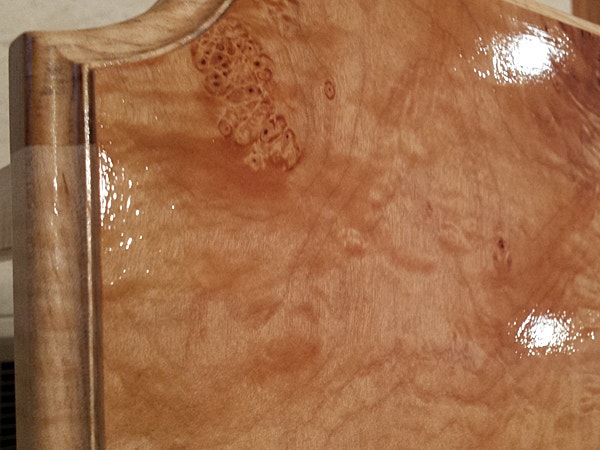How to Fix a Fish-eyed Finish?
I am finishing a maple burl veneer tabletop that has now developed significant orange peel in the new finish. To enhance the grain and color, I used a boiled linseed oil to stain and pop the grain, and let it dry thoroughly (over a week). I then used General Finishes Arm-R-Seal wipe-on topcoat. The first few coats dried smooth (sanded to 400-grit between coats), but the last two of the six coats showed the orange peel and some streaking. The temperature in the room was around 75 degrees, which I thought would be ideal. What did I do wrong? Were the coats too thick? Should I have thinned the material (the can says not to thin). Was the room too warm? Most importantly, what do I do now? – Ken Zoller
Tim Inman: This is not orange peel. This dimpling in the surface is a defect that finishers commonly call "fish-eye." Orange peel is caused by incorrect spray application. Usually, the material is too thick and the air pressure is too high. Other things can cause this, too. But orange peel is always a spraying defect. On the other hand, fish-eye is a chemical problem.
Usually the trouble tracks back to the presence of silicone in or on the wood surface. The silicone is there as an oily substance. It may have arrived on the scene as a lubricant; WD-40 is famous for causing fish-eye problems. Or it might have come in on an automobile wax. Auto waxes are quick shine and quick polish because of the silicone component in them. An old wives tale favorite furniture polish is simple mayonnaise. This causes the world's most disastrous cases of fish-eye! Never use it, please.
As any refinisher in business for more than six months will tell you, fish-eye is chronic once it takes root. It is very difficult to conquer. Why? Because most of the solvents in finishes will dissolve the silicone oils and allow them to float back up to the surface of the last coating, where the little dimples can start all over again. Shellac is my go-to to solution for fixing fish-eye. It's soluble in alcohol, but silicone oil is not. So the shellac can seal in the silicone oils. However, if you use sandpaper to smooth the shellac, you will cut nice little openings through it, which will allow the silicone to get loose and float back up. Yes, it is that insidious! There are also commercial fish-eye destroyer compounds available at most paint shops. Beware of their use, and if you do use them, use them exactly as prescribed. They are, in fact, just more silicone oil added to blend with that already on your project. Used correctly, they are wonderful; used haphazardly, and they will be your worst nightmare. They also have the ability to plasticize or soften your nice new finish coats. So, I'm back to shellac. Oh, and one last thing: Once you've got a nice smooth finish, STOP and enjoy it. Don't put on just one more coat to make it better. That fish-eye oil can pop up and ruin your finish at any time
Keep the inspiration coming!
Subscribe to our newsletter for more woodworking tips and tricks




